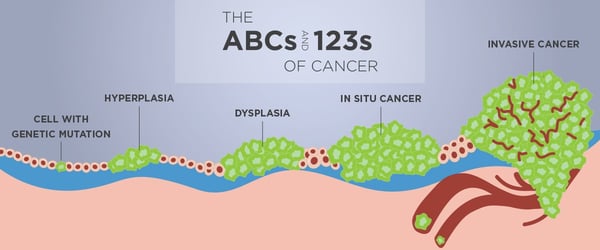
Stages.
Lymph nodes.
Metastasis.
The words, letters and numbers used to describe cancer can be confusing, but they are essential not only for the doctors caring for patients, but also for patients, family and friends to understand a cancer diagnosis. This guide will explain some of the medical terms and offer insight into what different cancer stages mean for patients’ care.
What is cancer staging?
Cancer staging describes the extent that the cancer has spread. It also gives the care team a standardized way to communicate.
The stage of a cancer provides information about the size of the tumor, which parts of the organ have the cancer, and whether it has metastasized or spread in the body.
Cancer staging also helps physicians determine:
- A patient’s prognosis or outlook
- How aggressive the cancer is
- The best form of treatment (including clinical trials)
- How well a treatment is likely to work
Cancer staging is universal, allowing patients and physicians alike to convey the same information when speaking about cancer care. To put this in perspective, the treatment and prognosis will be similar for cancers of the same organ and with the same stage (ex: Stage II lung cancer).
When is the stage of a cancer determined?
The first step of determining a cancer’s stage is discovering the cancer. This can happen through screening tests like colonoscopies, or when patients themselves find an abnormality, like a lump in a breast.
In addition to a physical exam, doctors perform certain tests to stage a cancer, including imaging studies, labs and taking a biopsy of the cancer. The results of these tests allow the doctor to accurately stage the cancer and formulate the best plan of care for the patient.
The Stages of Cancer
Different staging systems are used for different types of cancer, but the most common is the TNM system. This staging system is traditionally used for solid tumors, such as colon, lung or breast cancer. There are other systems used for staging other types of cancers, such as lymphomas or leukemias.
In TNM staging:
- T stands for Tumor and describes the size of the tumor and how deep it has grown into the organ or nearby tissues. T is usually given a number 1-4, with higher numbers correlating to a bigger sized or more invasive cancer.
- N represents lymph Nodes (small, bean-shaped organs that help the body fight infection) and describes whether the cancer has spread to lymph nodes around the tumor. N is also given a number, for instance N1 to N3, and the number increases to describe the number of lymph nodes that contain cancer.
- M indicates Metastasis, or whether the cancer has spread to other parts of the body.
Doctors use the TNM staging system to formulate the stage of a patient’s cancer.
Stages 1-4 are described with the Roman numerals I, II, III, and IV. Sometimes stages are further subdivided using the letters A, B and C that indicate certain characteristics found on work-up of the cancer.
- Stage 0 – This is precancerous and non-invasive. This is also known as “carcinoma in situ,” or cancer that is only present in the cells where it started. It has not spread to any nearby tissues.
- Stage I – The tumor is usually small and has just begun growing into nearby tissues, but its invasion does not have much depth. Stage 1 tumors have not spread to nearby lymph nodes or major organs.
- Stage II – These tumors are larger, have grown into nearby tissue, and have potentially spread into the lymph nodes.
- Stage III – These cancers are more advanced and aggressive than Stage II.
- Stage IV – This is the highest stage. These cancers have metastasized, or spread to distant parts of the body.
Treatment options are unique for different types and stages of cancer. For instance, patients with Stage I lung cancer will receive different treatments than patients who have Stage IV lung cancer, and patients with Stage 2 breast cancer will likely receive a different treatment than patients with Stage 2 colon cancer.
Treatment is based on evidence-driven medicine. Sometimes cancer patients may only require surgery. But some patients’ cancer may necessitate a combination of surgery, chemotherapy and radiation. Other treatment options include immunotherapy, biologic treatment, hormone therapy, molecular targeted therapy or participation in a clinical trial. Every cancer is unique, so each person’s treatment plan is specially formulated for the best possible outcome for their body.
Most importantly, the earlier a tumor is found and treated, the more likely it is to have a better outcome, so physicians encourage everyone to follow the American Cancer Society’s recommended guidelines for cancer screenings.
https://marybird.org/blog/olol/the-abcs-and-123s-of-cancer-stages/


.png?width=110&height=110&name=lane%20badge%20(1).png)
